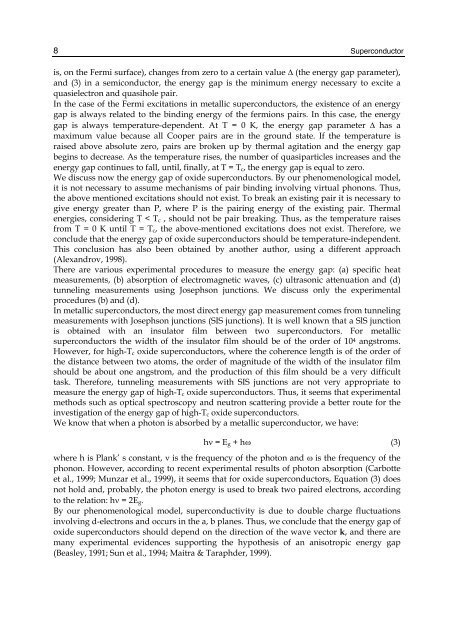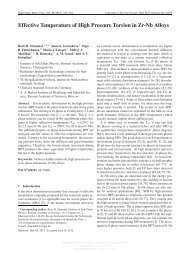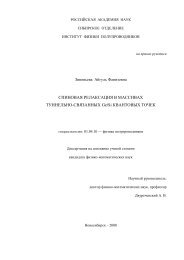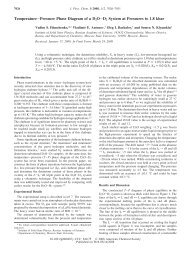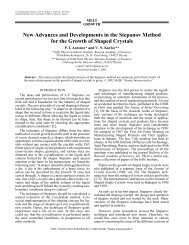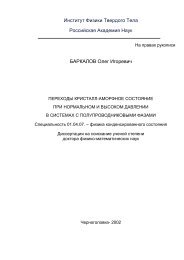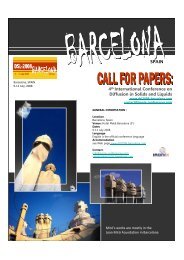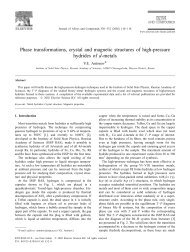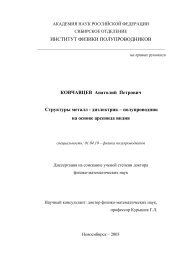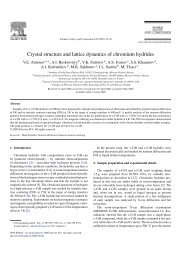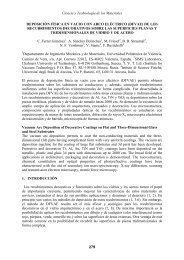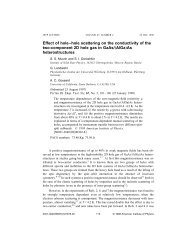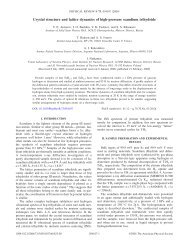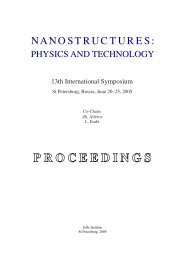Superconductor
Superconductor
Superconductor
Create successful ePaper yourself
Turn your PDF publications into a flip-book with our unique Google optimized e-Paper software.
8<br />
<strong>Superconductor</strong><br />
is, on the Fermi surface), changes from zero to a certain value Δ (the energy gap parameter),<br />
and (3) in a semiconductor, the energy gap is the minimum energy necessary to excite a<br />
quasielectron and quasihole pair.<br />
In the case of the Fermi excitations in metallic superconductors, the existence of an energy<br />
gap is always related to the binding energy of the fermions pairs. In this case, the energy<br />
gap is always temperature-dependent. At T = 0 K, the energy gap parameter Δ has a<br />
maximum value because all Cooper pairs are in the ground state. If the temperature is<br />
raised above absolute zero, pairs are broken up by thermal agitation and the energy gap<br />
begins to decrease. As the temperature rises, the number of quasiparticles increases and the<br />
energy gap continues to fall, until, finally, at T = Tc, the energy gap is equal to zero.<br />
We discuss now the energy gap of oxide superconductors. By our phenomenological model,<br />
it is not necessary to assume mechanisms of pair binding involving virtual phonons. Thus,<br />
the above mentioned excitations should not exist. To break an existing pair it is necessary to<br />
give energy greater than P, where P is the pairing energy of the existing pair. Thermal<br />
energies, considering T < Tc , should not be pair breaking. Thus, as the temperature raises<br />
from T = 0 K until T = Tc, the above-mentioned excitations does not exist. Therefore, we<br />
conclude that the energy gap of oxide superconductors should be temperature-independent.<br />
This conclusion has also been obtained by another author, using a different approach<br />
(Alexandrov, 1998).<br />
There are various experimental procedures to measure the energy gap: (a) specific heat<br />
measurements, (b) absorption of electromagnetic waves, (c) ultrasonic attenuation and (d)<br />
tunneling measurements using Josephson junctions. We discuss only the experimental<br />
procedures (b) and (d).<br />
In metallic superconductors, the most direct energy gap measurement comes from tunneling<br />
measurements with Josephson junctions (SIS junctions). It is well known that a SlS junction<br />
is obtained with an insulator film between two superconductors. For metallic<br />
superconductors the width of the insulator film should be of the order of 10 4 angstroms.<br />
However, for high-Tc oxide superconductors, where the coherence length is of the order of<br />
the distance between two atoms, the order of magnitude of the width of the insulator film<br />
should be about one angstrom, and the production of this film should be a very difficult<br />
task. Therefore, tunneling measurements with SIS junctions are not very appropriate to<br />
measure the energy gap of high-Tc oxide superconductors. Thus, it seems that experimental<br />
methods such as optical spectroscopy and neutron scattering provide a better route for the<br />
investigation of the energy gap of high-Tc oxide superconductors.<br />
We know that when a photon is absorbed by a metallic superconductor, we have:<br />
hν = Eg + hω (3)<br />
where h is Plank’ s constant, ν is the frequency of the photon and ω is the frequency of the<br />
phonon. However, according to recent experimental results of photon absorption (Carbotte<br />
et al., 1999; Munzar et al., 1999), it seems that for oxide superconductors, Equation (3) does<br />
not hold and, probably, the photon energy is used to break two paired electrons, according<br />
to the relation: hν = 2Eg.<br />
By our phenomenological model, superconductivity is due to double charge fluctuations<br />
involving d-electrons and occurs in the a, b planes. Thus, we conclude that the energy gap of<br />
oxide superconductors should depend on the direction of the wave vector k, and there are<br />
many experimental evidences supporting the hypothesis of an anisotropic energy gap<br />
(Beasley, 1991; Sun et al., 1994; Maitra & Taraphder, 1999).


